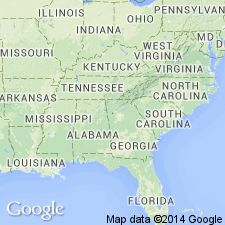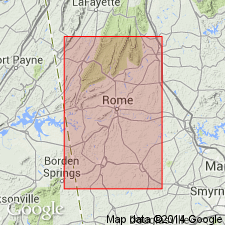
- Usage in publication:
-
- Deaton ore beds
- Deaton series
- Modifications:
-
- Original reference
- Dominant lithology:
-
- Limestone
- AAPG geologic province:
-
- Appalachian basin
Summary:
Pg. 46, 83. Deaton ore beds or series. Ferruginous limestones, 100 to 200 feet thick, included in Chickamauga series of Polk County and probably of Whitfield County, northwestern Georgia. Underlie Rockmart slate and overlie Maclurea limestone. Age is Middle Ordovician.
[Named from exposures at Deaton mine, Polk Co., northwestern GA.]
[GNC remark (US geologic names lexicon, USGS Bull. 896, p. 579): According C.W. Hayes (USGS Rome folio, no. 78, 1902) these beds belong in lower part of Rockmart slate and rest on Chickamauga limestone.]
Source: US geologic names lexicon (USGS Bull. 896, p. 579).

- Usage in publication:
-
- Deaton Member*
- Modifications:
-
- Revised
- AAPG geologic province:
-
- Appalachian basin
Summary:
Deaton assigned as member of Lenoir Limestone. Age is Middle Ordovician.
Source: GNU records (USGS DDS-6; Reston GNULEX).
For more information, please contact Nancy Stamm, Geologic Names Committee Secretary.
Asterisk (*) indicates published by U.S. Geological Survey authors.
"No current usage" (†) implies that a name has been abandoned or has fallen into disuse. Former usage and, if known, replacement name given in parentheses ( ).
Slash (/) indicates name conflicts with nomenclatural guidelines (CSN, 1933; ACSN, 1961, 1970; NACSN, 1983, 2005, 2021). May be explained within brackets ([ ]).

